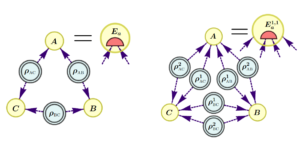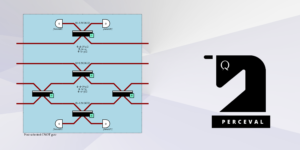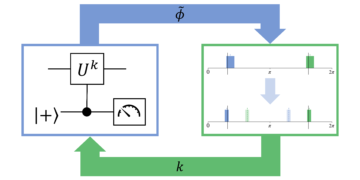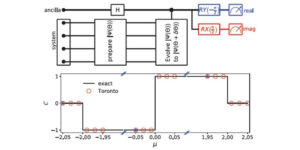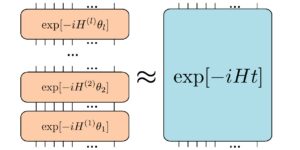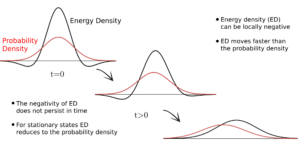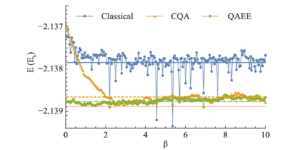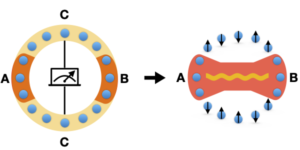Abstract
The device-independent framework constitutes the most pragmatic approach to quantum protocols that does not put any trust in their implementations. It requires all claims, about e.g. security, to be made at the level of the final classical data in hands of the end-users. This imposes a great challenge for determining attainable key rates in $textit{device-independent quantum key distribution}$ (DIQKD), but also opens the door for consideration of eavesdropping attacks that stem from the possibility of a given data being just generated by a malicious third-party. In this work, we explore this path and present the $textit{convex-combination attack}$ as an efficient, easy-to-use technique for upper-bounding DIQKD key rates. It allows verifying the accuracy of lower bounds on key rates for state-of-the-art protocols, whether involving one-way or two-way communication. In particular, we demonstrate with its help that the currently predicted constraints on the robustness of DIQKD protocols to experimental imperfections, such as the finite visibility or detection efficiency, are already very close to the ultimate tolerable thresholds.
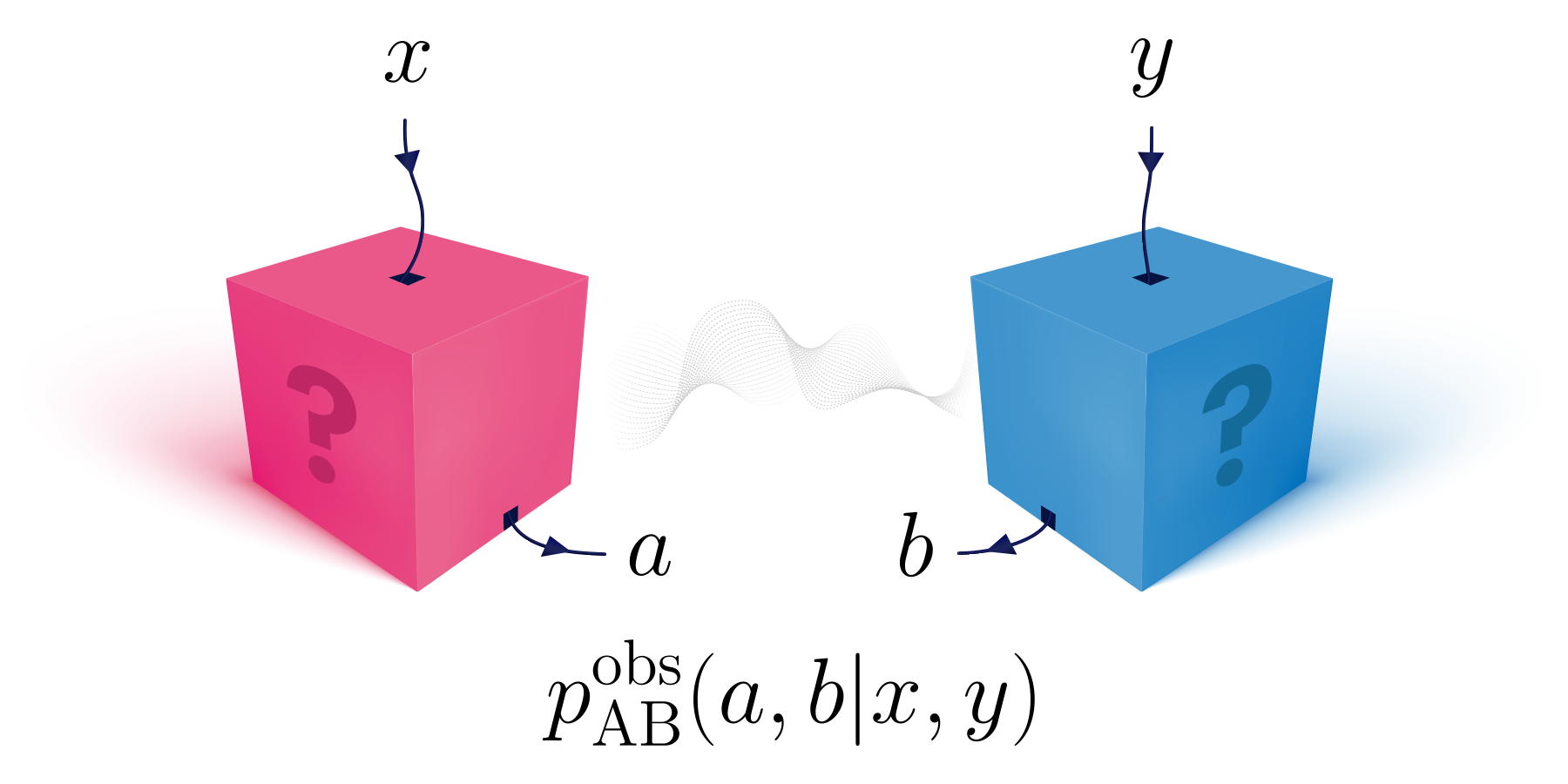
Popular summary
► BibTeX data
► References
[1] Antonio Acín, Nicolas Brunner, Nicolas Gisin, Serge Massar, Stefano Pironio, and Valerio Scarani. ``Device-independent security of quantum cryptography against collective attacks''. Phys. Rev. Lett. 98, 230501 (2007).
https://doi.org/10.1103/PhysRevLett.98.230501
[2] Stefano Pironio, Antonio Acín, Nicolas Brunner, Nicolas Gisin, Serge Massar, and Valerio Scarani. ``Device-independent quantum key distribution secure against collective attacks''. New J. Phys. 11, 045021 (2009).
https://doi.org/10.1088/1367-2630/11/4/045021
[3] Claude E. Shannon. ``Communication theory of secrecy systems''. The Bell System Technical Journal 28, 656–715 (1949).
https://doi.org/10.1002/j.1538-7305.1949.tb00928.x
[4] Nicolas Brunner, Daniel Cavalcanti, Stefano Pironio, Valerio Scarani, and Stephanie Wehner. ``Bell nonlocality''. Rev. Mod. Phys. 86, 419–478 (2014).
https://doi.org/10.1103/RevModPhys.86.419
[5] Jonathan Barrett, Lucien Hardy, and Adrian Kent. ``No signaling and quantum key distribution''. Phys. Rev. Lett. 95, 010503 (2005).
https://doi.org/10.1103/PhysRevLett.95.010503
[6] Antonio Acín, Nicolas Gisin, and Lluis Masanes. ``From Bell's theorem to secure quantum key distribution''. Phys. Rev. Lett. 97, 120405 (2006).
https://doi.org/10.1103/PhysRevLett.97.120405
[7] Antonio Acín, Serge Massar, and Stefano Pironio. ``Efficient quantum key distribution secure against no-signalling eavesdroppers''. New J. Phys. 8, 126–126 (2006).
https://doi.org/10.1088/1367-2630/8/8/126
[8] Yi Zhao, Chi-Hang Fred Fung, Bing Qi, Christine Chen, and Hoi-Kwong Lo. ``Quantum hacking: Experimental demonstration of time-shift attack against practical quantum-key-distribution systems''. Phys. Rev. A 78, 042333 (2008).
https://doi.org/10.1103/PhysRevA.78.042333
[9] Feihu Xu, Bing Qi, and Hoi-Kwong Lo. ``Experimental demonstration of phase-remapping attack in a practical quantum key distribution system''. New J. Phys. 12, 113026 (2010).
https://doi.org/10.1088/1367-2630/12/11/113026
[10] Lars Lydersen, Carlos Wiechers, Christoffer Wittmann, Dominique Elser, Johannes Skaar, and Vadim Makarov. ``Hacking commercial quantum cryptography systems by tailored bright illumination''. Nat. Photonics 4, 686–689 (2010).
https://doi.org/10.1038/nphoton.2010.214
[11] Ilja Gerhardt, Qin Liu, Antía Lamas-Linares, Johannes Skaar, Christian Kurtsiefer, and Vadim Makarov. ``Full-field implementation of a perfect eavesdropper on a quantum cryptography system''. Nat. Commun. 2, 349 (2011).
https://doi.org/10.1038/ncomms1348
[12] Valerio Scarani, Helle Bechmann-Pasquinucci, Nicolas J. Cerf, Miloslav Dušek, Norbert Lütkenhaus, and Momtchil Peev. ``The security of practical quantum key distribution''. Rev. Mod. Phys. 81, 1301–1350 (2009).
https://doi.org/10.1103/RevModPhys.81.1301
[13] Rotem Arnon-Friedman, Frédéric Dupuis, Omar Fawzi, Renato Renner, and Thomas Vidick. ``Practical device-independent quantum cryptography via entropy accumulation''. Nat. Commun. 9, 459 (2018).
https://doi.org/10.1038/s41467-017-02307-4
[14] Gláucia Murta, Suzanne B. van Dam, Jérémy Ribeiro, Ronald Hanson, and Stephanie Wehner. ``Towards a realization of device-independent quantum key distribution''. Quantum Sci. Technol. 4, 035011 (2019).
https://doi.org/10.1088/2058-9565/ab2819
[15] René Schwonnek, Koon Tong Goh, Ignatius W. Primaatmaja, Ernest Y.-Z. Tan, Ramona Wolf, Valerio Scarani, and Charles C.-W. Lim. ``Device-independent quantum key distribution with random key basis''. Nat Commun 12, 2880 (2021).
https://doi.org/10.1038/s41467-021-23147-3
[16] Igor Devetak and Andreas Winter. ``Distillation of secret key and entanglement from quantum states''. Proc. R. Soc. Lond. A 461, 207–235 (2005).
https://doi.org/10.1098/rspa.2004.1372
[17] Renato Renner, Nicolas Gisin, and Barbara Kraus. ``Information-theoretic security proof for quantum-key-distribution protocols''. Phys. Rev. A 72, 012332 (2005).
https://doi.org/10.1103/PhysRevA.72.012332
[18] Rotem Arnon-Friedman. ``Device-independent quantum information processing''. Springer Theses (2020).
https://doi.org/10.1007/978-3-030-60231-4
[19] Yanbao Zhang, Honghao Fu, and Emanuel Knill. ``Efficient randomness certification by quantum probability estimation''. Phys. Rev. Research 2, 013016 (2020).
https://doi.org/10.1103/PhysRevResearch.2.013016
[20] John F. Clauser, Michael A. Horne, Abner Shimony, and Richard A. Holt. ``Proposed experiment to test local hidden-variable theories''. Phys. Rev. Lett. 23, 880–884 (1969).
https://doi.org/10.1103/PhysRevLett.23.880
[21] Antonio Acín, Serge Massar, and Stefano Pironio. ``Randomness versus nonlocality and entanglement''. Phys. Rev. Lett. 108, 100402 (2012).
https://doi.org/10.1103/PhysRevLett.108.100402
[22] Erik Woodhead, Antonio Acín, and Stefano Pironio. ``Device-independent quantum key distribution with asymmetric CHSH inequalities''. Quantum 5, 443 (2021).
https://doi.org/10.22331/q-2021-04-26-443
[23] Melvyn Ho, Pavel Sekatski, Ernest Y.-Z. Tan, Renato Renner, Jean-Daniel Bancal, and Nicolas Sangouard. ``Noisy preprocessing facilitates a photonic realization of device-independent quantum key distribution''. Phys. Rev. Lett. 124, 230502 (2020).
https://doi.org/10.1103/PhysRevLett.124.230502
[24] Pavel Sekatski, Jean-Daniel Bancal, Xavier Valcarce, Ernest Y.-Z. Tan, Renato Renner, and Nicolas Sangouard. ``Device-independent quantum key distribution from generalized CHSH inequalities''. Quantum 5, 444 (2021).
https://doi.org/10.22331/q-2021-04-26-444
[25] Robert König, Renato Renner, and Christian Schaffner. ``The operational meaning of min- and max-entropy''. IEEE Trans. Inf. Theory 55, 4337–4347 (2009).
https://doi.org/10.1109/TIT.2009.2025545
[26] Lluís Masanes, Stefano Pironio, and Antonio Acín. ``Secure device-independent quantum key distribution with causally independent measurement devices''. Nat Commun 2, 238 (2011).
https://doi.org/10.1038/ncomms1244
[27] Olmo Nieto-Silleras, Stefano Pironio, and Jonathan Silman. ``Using complete measurement statistics for optimal device-independent randomness evaluation''. New J. Phys. 16, 013035 (2014).
https://doi.org/10.1088/1367-2630/16/1/013035
[28] Jean-Daniel Bancal, Lana Sheridan, and Valerio Scarani. ``More randomness from the same data''. New J. Phys. 16, 033011 (2014).
https://doi.org/10.1088/1367-2630/16/3/033011
[29] Alejandro Máttar, Paul Skrzypczyk, Jonatan Bohr Brask, Daniel Cavalcanti, and Antonio Acín. ``Optimal randomness generation from optical Bell experiments''. New J. Phys. 17, 022003 (2015).
https://doi.org/10.1088/1367-2630/17/2/022003
[30] Jan Kołodyński, Alejandro Máttar, Paul Skrzypczyk, Erik Woodhead, Daniel Cavalcanti, Konrad Banaszek, and Antonio Acín. ``Device-independent quantum key distribution with single-photon sources''. Quantum 4, 260 (2020).
https://doi.org/10.22331/q-2020-04-30-260
[31] Miguel Navascués, Stefano Pironio, and Antonio Acín. ``Bounding the set of quantum correlations''. Phys. Rev. Lett. 98, 010401 (2007).
https://doi.org/10.1103/PhysRevLett.98.010401
[32] Miguel Navascués, Stefano Pironio, and Antonio Acín. ``A convergent hierarchy of semidefinite programs characterizing the set of quantum correlations''. New Journal of Physics 10, 073013 (2008).
https://doi.org/10.1088/1367-2630/10/7/073013
[33] Feihu Xu, Yu-Zhe Zhang, Qiang Zhang, and Jian-Wei Pan. ``Device-independent quantum key distribution with random postselection''. Phys. Rev. Lett. 128, 110506 (2022).
https://doi.org/10.1103/PhysRevLett.128.110506
[34] Le Phuc Thinh, Gonzalo de la Torre, Jean-Daniel Bancal, Stefano Pironio, and Valerio Scarani. ``Randomness in post-selected events''. New Journal of Physics 18, 035007 (2016).
https://doi.org/10.1088/1367-2630/18/3/035007
[35] Peter Brown, Hamza Fawzi, and Omar Fawzi. ``Device-independent lower bounds on the conditional von Neumann entropy'' (2021). arXiv:2106.13692.
arXiv:2106.13692
[36] Peter Brown, Hamza Fawzi, and Omar Fawzi. ``Computing conditional entropies for quantum correlations''. Nat Commun 12, 575 (2021).
https://doi.org/10.1038/s41467-020-20018-1
[37] Ernest Y.-Z. Tan, René Schwonnek, Koon Tong Goh, Ignatius William Primaatmaja, and Charles C.-W. Lim. ``Computing secure key rates for quantum cryptography with untrusted devices''. npj Quantum Inf 7, 1–6 (2021).
https://doi.org/10.1038/s41534-021-00494-z
[38] Eneet Kaur, Mark M Wilde, and Andreas Winter. ``Fundamental limits on key rates in device-independent quantum key distribution''. New J. Phys. 22, 023039 (2020).
https://doi.org/10.1088/1367-2630/ab6eaa
[39] Matthias Christandl, Roberto Ferrara, and Karol Horodecki. ``Upper bounds on device-independent quantum key distribution''. Phys. Rev. Lett. 126, 160501 (2021).
https://doi.org/10.1103/PhysRevLett.126.160501
[40] Rotem Arnon-Friedman and Felix Leditzky. ``Upper bounds on device-independent quantum key distribution rates and a revised Peres conjecture''. IEEE Trans. Inf. Theory 67, 6606–6618 (2021).
https://doi.org/10.1109/TIT.2021.3086505
[41] Máté Farkas, Maria Balanzó-Juandó, Karol Łukanowski, Jan Kołodyński, and Antonio Acín. ``Bell nonlocality is not sufficient for the security of standard device-independent quantum key distribution protocols''. Phys. Rev. Lett. 127, 050503 (2021).
https://doi.org/10.1103/PhysRevLett.127.050503
[42] Ernest Y.-Z. Tan, Charles C.-W. Lim, and Renato Renner. ``Advantage distillation for device-independent quantum key distribution''. Phys. Rev. Lett. 124, 020502 (2020).
https://doi.org/10.1103/PhysRevLett.124.020502
[43] Imre Csiszár and János Körner. ``Broadcast channels with confidential messages''. IEEE Trans. Inf. Theory 24, 339–348 (1978).
https://doi.org/10.1109/TIT.1978.1055892
[44] Ueli Maurer. ``Secret key agreement by public discussion from common information''. IEEE Trans. Inf. Theory 39, 733–742 (1993).
https://doi.org/10.1109/18.256484
[45] Rudolf Ahlswede and Imre Csiszár. ``Common randomness in information theory and cryptography. I. Secret sharing''. IEEE Trans. Inf. Theory 39, 1121–1132 (1993).
https://doi.org/10.1109/18.243431
[46] Eneet Kaur, Karol Horodecki, and Siddhartha Das. ``Upper bounds on device-independent quantum key distribution rates in static and dynamic scenarios''. Phys. Rev. Appl. 18, 054033 (2022).
https://doi.org/10.1103/PhysRevApplied.18.054033
[47] Michele Masini, Stefano Pironio, and Erik Woodhead. ``Simple and practical DIQKD security analysis via BB84-type uncertainty relations and Pauli correlation constraints''. Quantum 6, 843 (2022).
https://doi.org/10.22331/q-2022-10-20-843
[48] Philippe H. Eberhard. ``Background level and counter efficiencies required for a loophole-free Einstein-Podolsky-Rosen experiment''. Phys. Rev. A 47, R747–R750 (1993).
https://doi.org/10.1103/PhysRevA.47.R747
[49] Junior R. Gonzales-Ureta, Ana Predojević, and Adán Cabello. ``Device-independent quantum key distribution based on Bell inequalities with more than two inputs and two outputs''. Phys. Rev. A 103, 052436 (2021).
https://doi.org/10.1103/PhysRevA.103.052436
[50] Daniel Collins and Nicolas Gisin. ``A relevant two qubit Bell inequality inequivalent to the CHSH inequality''. J. Phys. A: Math. Gen. 37, 1775–1787 (2004).
https://doi.org/10.1088/0305-4470/37/5/021
[51] Stefano Pironio, Lluis Masanes, Anthony Leverrier, and Antonio Acín. ``Security of device-independent quantum key distribution in the bounded-quantum-storage model''. Phys. Rev. X 3, 031007 (2013).
https://doi.org/10.1103/PhysRevX.3.031007
[52] Xiongfeng Ma and Norbert Lutkenhaus. ``Improved data post-processing in quantum key distribution and application to loss thresholds in device independent QKD''. Quantum Information and Computation 12, 203–214 (2012).
https://doi.org/10.26421/qic12.3-4-2
[53] Ignatius W. Primaatmaja, Koon Tong Goh, Ernest Y.-Z. Tan, John T.-F. Khoo, Shouvik Ghorai, and Charles C.-W. Lim. ``Security of device-independent quantum key distribution protocols: a review''. Quantum 7, 932 (2023).
https://doi.org/10.22331/q-2023-03-02-932
[54] Ernest Y.-Z. Tan, Pavel Sekatski, Jean-Daniel Bancal, René Schwonnek, Renato Renner, Nicolas Sangouard, and Charles C.-W. Lim. ``Improved DIQKD protocols with finite-size analysis''. Quantum 6, 880 (2022).
https://doi.org/10.22331/q-2022-12-22-880
[55] Ueli Maurer and Stefan Wolf. ``The intrinsic conditional mutual information and perfect secrecy''. In Proceedings of IEEE International Symposium on Information Theory. IEEE (1997).
https://doi.org/10.1109/isit.1997.613003
[56] Matthias Christandl, Artur Ekert, Michał Horodecki, Paweł Horodecki, Jonathan Oppenheim, and Renato Renner. ``Unifying classical and quantum key distillation''. In Vadhan, S.P. (eds) Theory of Cryptography. TCC 2007. Volume 4392 of Lecture Notes in Computer Science, pages 456–478. Berlin, Heidelberg (2007). Springer.
https://doi.org/10.1007/978-3-540-70936-7_25
[57] Marek Winczewski, Tamoghna Das, and Karol Horodecki. ``Limitations on a device-independent key secure against a nonsignaling adversary via squashed nonlocality''. Phys. Rev. A 106, 052612 (2022).
https://doi.org/10.1103/PhysRevA.106.052612
[58] David Avis, Hiroshi Imai, Tsuyoshi Ito, and Yuuya Sasaki. ``Two-party Bell inequalities derived from combinatorics via triangular elimination''. J. Phys. A 38, 10971–10987 (2005).
https://doi.org/10.1088/0305-4470/38/50/007
[59] Boris S. Cirel'son. ``Quantum generalizations of Bell's inequality''. Letters in Mathematical Physics 4, 93–100 (1980).
https://doi.org/10.1007/bf00417500
[60] Stephen Boyd and Lieven Vandenberghe. ``Convex optimization''. Cambridge University Press. (2004).
https://doi.org/10.1017/CBO9780511804441
[61] Víctor Zapatero and Marcos Curty. ``Long-distance device-independent quantum key distribution''. Sci Rep 9, 1–18 (2019).
https://doi.org/10.1038/s41598-019-53803-0
[62] N. David Mermin. ``The EPR Experiment—Thoughts about the ``Loophole''''. Ann. N.Y. Acad. Sci. 480, 422–427 (1986).
https://doi.org/10.1111/j.1749-6632.1986.tb12444.x
[63] Erik Woodhead, Jędrzej Kaniewski, Boris Bourdoncle, Alexia Salavrakos, Joseph Bowles, Antonio Acín, and Remigiusz Augusiak. ``Maximal randomness from partially entangled states''. Phys. Rev. Research 2, 042028 (2020).
https://doi.org/10.1103/PhysRevResearch.2.042028
[64] Tamás Vértesi, Stefano Pironio, and Nicolas Brunner. ``Closing the detection loophole in Bell experiments using qudits''. Phys. Rev. Lett. 104, 060401 (2010).
https://doi.org/10.1103/PhysRevLett.104.060401
[65] Nicolas Brunner and Nicolas Gisin. ``Partial list of bipartite Bell inequalities with four binary settings''. Phys. Lett. A 372, 3162–3167 (2008).
https://doi.org/10.1016/j.physleta.2008.01.052
[66] Adán Cabello. ````All versus nothing'' inseparability for two observers''. Phys. Rev. Lett. 87, 010403 (2001).
https://doi.org/10.1103/PhysRevLett.87.010403
[67] Yu-Zhe Zhang, Yi-Zheng Zhen, and Feihu Xu. ``Upper bound on device-independent quantum key distribution with two way classical postprocessing under individual attack''. New Journal of Physics 24, 113045 (2022).
https://doi.org/10.1088/1367-2630/aca34b
[68] Daniel Collins, Nicolas Gisin, Noah Linden, Serge Massar, and Sandu Popescu. ``Bell inequalities for arbitrarily high-dimensional systems''. Phys. Rev. Lett. 88, 040404 (2002).
https://doi.org/10.1103/PhysRevLett.88.040404
Cited by
[1] Giuseppe Viola, Nikolai Miklin, Mariami Gachechiladze, and Marcin Pawłowski, "Entanglement witnessing with untrusted detectors", Journal of Physics A Mathematical General 56 42, 425301 (2023).
[2] Ignatius W. Primaatmaja, Koon Tong Goh, Ernest Y. -Z. Tan, John T. -F. Khoo, Shouvik Ghorai, and Charles C. -W. Lim, "Security of device-independent quantum key distribution protocols: a review", Quantum 7, 932 (2023).
[3] Eva M. González-Ruiz, Javier Rivera-Dean, Marina F. B. Cenni, Anders S. Sørensen, Antonio Acín, and Enky Oudot, "Device Independent Quantum Key Distribution with realistic single-photon source implementations", arXiv:2211.16472, (2022).
[4] Yu-Zhe Zhang, Yi-Zheng Zhen, and Feihu Xu, "Upper bound on device-independent quantum key distribution with two way classical postprocessing under individual attack", New Journal of Physics 24 11, 113045 (2022).
The above citations are from SAO/NASA ADS (last updated successfully 2023-12-07 14:36:49). The list may be incomplete as not all publishers provide suitable and complete citation data.
On Crossref's cited-by service no data on citing works was found (last attempt 2023-12-07 14:36:47).
This Paper is published in Quantum under the Creative Commons Attribution 4.0 International (CC BY 4.0) license. Copyright remains with the original copyright holders such as the authors or their institutions.
- SEO Powered Content & PR Distribution. Get Amplified Today.
- PlatoData.Network Vertical Generative Ai. Empower Yourself. Access Here.
- PlatoAiStream. Web3 Intelligence. Knowledge Amplified. Access Here.
- PlatoESG. Carbon, CleanTech, Energy, Environment, Solar, Waste Management. Access Here.
- PlatoHealth. Biotech and Clinical Trials Intelligence. Access Here.
- Source: https://quantum-journal.org/papers/q-2023-12-06-1199/
- :has
- :is
- :not
- ][p
- 01
- 1
- 10
- 11
- 12
- 13
- 14
- 15%
- 16
- 17
- 1800
- 19
- 1949
- 20
- 2001
- 2005
- 2006
- 2008
- 2010
- 2011
- 2012
- 2013
- 2014
- 2015
- 2016
- 2018
- 2019
- 2020
- 2021
- 2022
- 2023
- 214
- 22
- 23
- 24
- 25
- 26
- 27
- 28
- 29
- 30
- 31
- 32
- 33
- 35%
- 36
- 39
- 40
- 41
- 43
- 46
- 49
- 50
- 51
- 52
- 53
- 54
- 58
- 60
- 65
- 66
- 67
- 7
- 72
- 8
- 87
- 9
- 97
- 98
- a
- About
- above
- ABSTRACT
- access
- accumulation
- accuracy
- adrian
- affiliations
- against
- Agreement
- All
- allows
- already
- also
- always
- an
- Ana
- analysis
- and
- Anthony
- any
- Application
- approach
- ARE
- AS
- At
- attack
- Attacks
- Attainable
- attempt
- author
- authors
- b
- barcelona
- based
- basis
- BE
- been
- being
- Bell
- berlin
- Bing
- boris
- bound
- bounds
- Break
- Bright
- brown
- but
- by
- cambridge
- CAN
- cannot
- carlos
- centre
- Certification
- challenge
- channels
- Charles
- chen
- christian
- Christine
- citing
- claims
- Close
- Collective
- Collins
- comes
- comment
- commercial
- Common
- Commons
- Communication
- complete
- computation
- computer
- computer science
- conditions
- conjecture
- consideration
- constraints
- copyright
- Correlation
- correlations
- Counter
- cryptographic
- cryptography
- Currently
- Daniel
- data
- David
- dec
- demanding
- demonstrate
- Den
- Derived
- Detection
- determining
- device
- Devices
- discuss
- discussion
- distribute
- distribution
- does
- Door
- dynamic
- e
- easy-to-use
- efficiencies
- efficiency
- efficient
- erik
- Ether (ETH)
- evaluation
- Even
- events
- exhibit
- exists
- experiment
- experimental
- experiments
- explained
- explore
- Explored
- facilitates
- far
- final
- For
- found
- four
- Framework
- from
- fu
- Gen
- General
- generated
- generation
- given
- great
- hacking
- Hands
- harvard
- help
- hierarchy
- holders
- However
- HTTPS
- i
- IEEE
- implementation
- implementations
- improving
- in
- independent
- individual
- inequalities
- Inequality
- information
- inputs
- Institute
- institutions
- interesting
- International
- intrinsic
- involving
- IT
- ITS
- Jan
- JavaScript
- Jian-Wei Pan
- John
- jonathan
- journal
- just
- Key
- keys
- Know
- König
- Last
- Leave
- Lecture
- Level
- License
- limits
- List
- local
- loophole
- loss
- lower
- made
- maria
- marina
- mark
- math
- mathematical
- mathematics
- matthias
- max-width
- May..
- meaning
- means
- measurement
- messages
- Michael
- model
- Month
- more
- most
- must
- mutual
- nearly
- New
- New technologies
- Nicolas
- no
- Noah
- Notes
- nothing
- now
- observed
- observers
- of
- omar
- on
- open
- opens
- operational
- optimal
- optimization
- or
- original
- our
- outputs
- pages
- PAN
- Paper
- particular
- path
- Paul
- perfect
- performed
- Peter
- Philippe
- Physics
- plato
- Plato Data Intelligence
- PlatoData
- possibility
- post-processing
- potential
- Practical
- pragmatic
- predicted
- present
- press
- price
- principle
- probability
- PROC
- Proceedings
- processing
- Programs
- proof
- proofs
- protocols
- provide
- providing
- public
- published
- publisher
- publishers
- put
- Qi
- quality
- Quantum
- quantum cryptography
- quantum information
- Qubit
- R
- random
- randomness
- Rates
- realistic
- realization
- references
- relations
- relaxed
- relevant
- remains
- required
- Requirements
- requires
- research
- review
- Ribeiro
- Richard
- ROBERT
- robustness
- s
- same
- scenarios
- SCI
- Science
- Science and Technology
- Secret
- secure
- securely
- security
- set
- settings
- sharing
- Simple
- So
- so Far
- solely
- son
- Source
- Sources
- standard
- state-of-the-art
- States
- statistics
- stefan
- Stem
- Stephen
- stringent
- Successfully
- such
- sufficient
- suitable
- Symposium
- system
- Systems
- T
- tailored
- Technical
- technique
- Technologies
- Technology
- test
- than
- thanks
- that
- The
- their
- then
- theory
- These
- third-party
- this
- Title
- to
- trans
- Trust
- two
- ultimate
- Uncertain
- Uncertainty
- under
- United
- university
- updated
- URL
- using
- vendor
- verifying
- Versus
- very
- via
- Viola
- visibility
- volume
- von
- W
- want
- Warsaw
- was
- Way..
- we
- when
- whether
- which
- william
- Winter
- with
- witnessing
- Wolf
- Work
- works
- X
- year
- york
- zephyrnet
- zhang
- Zhao



